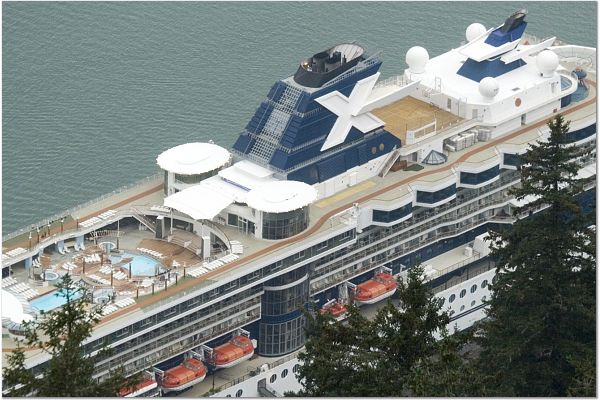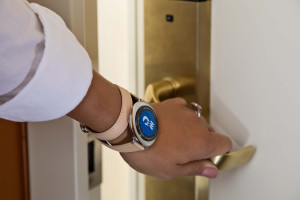 If you’ve ever been on a cruise and decided that leaving your emails behind just wasn’t for you, you probably wished you had. Understandably some people need to stay connected even while on vacation….maybe for work purposes or to stay in touch with a sick relative or just to chronicle the vacation to friends on facebook back home. The frustrations of online connectivity while sailing at sea aboard a passenger cruise ship has long been a thorn in the industries bow and stern. Slow connections and dropped communications coupled with charges so deep even the waters of the Atlantic Ocean couldn’t compare, have long been maddening and mounting means of angst in an otherwise blissful vacation experience. Fortunately, that’s about to change.
If you’ve ever been on a cruise and decided that leaving your emails behind just wasn’t for you, you probably wished you had. Understandably some people need to stay connected even while on vacation….maybe for work purposes or to stay in touch with a sick relative or just to chronicle the vacation to friends on facebook back home. The frustrations of online connectivity while sailing at sea aboard a passenger cruise ship has long been a thorn in the industries bow and stern. Slow connections and dropped communications coupled with charges so deep even the waters of the Atlantic Ocean couldn’t compare, have long been maddening and mounting means of angst in an otherwise blissful vacation experience. Fortunately, that’s about to change.
Faced with accelerating demands by passengers for digital connections for their mobile devices, cruise lines are pushing vendors for faster, cheaper, more reliable telecommunications at sea. In response, the satellite providers are getting creative in their efforts to provide the bandwidth that enables Internet access, social media use and other telecom services. Solutions include creating a hybrid of satellite and land-based carrier networks, installing additional antennae on ships for more flexible, reliable signal tracking and using satellites in lower orbits to reduce signal transmission times. In some cases, passengers can expect a “dramatic” rise in the speed of Internet access from the ships, one analyst said. The innovations from companies such as MTN Satellite Communications and Harris CapRock are being implemented now, although they won’t start being ready for use until next year or 2015. 
“There are a whole series of new technologies and satellites that are going to be available in the coming couple of years that will greatly improve the performance and the available bandwidth on those ships,” said Rick Simonian, president of maritime solutions at Harris CapRock. With its purchase of CapRock Communications in 2010, Harris Corp. embraced a commitment to the cruise ship segment. Since then, it has won contracts with Royal Caribbean Cruises Ltd. and Carnival Corp. to install new equipment and provide services. Its contract with Carnival, disclosed in mid-October, covers more than 100 ships in the fleets of 10 Carnival brands. Harris CapRock said it will provide bandwidth levels higher than those previously available on each fleet to meet “new service requirements Carnival set for its guests and crew.” Simonian said a key piece of the puzzle is installation of more than one satellite antenna on each ship. Most ships, he said, have a single antenna, housed in a spherical dome fixed to the ship’s mast.
 “The problem with that is that if the ship is turning and the line of sight to the satellite gets blocked by the smokestack, or if they’re in some other obstruction, then the service goes down,” he said.
“The problem with that is that if the ship is turning and the line of sight to the satellite gets blocked by the smokestack, or if they’re in some other obstruction, then the service goes down,” he said.
Two antennae mitigate that problem and will also be capable of switching back and forth between different radio frequencies, C-band and Ku-band, using the resiliency of one and the greater bandwidth of the other as conditions change.
Earlier this year, Harris CapRock completed installing gear on 33 ships belonging to Royal Caribbean International, Celebrity Cruises and Azamara Club Cruises. It will also integrate an ambitious new satellite system from O3b Networks, starting with the Oasis and Allure of the Seas. O3b is launching satellites that orbit about 8,000 miles above the Earth, rather than the 23,000-mile distance of existing, geostationary satellites. That cuts the back-and-forth signal speed to the satellites from 720 milliseconds to 130 milliseconds. “It will dramatically increase the amount of bandwidth available, to kind of unheard-of rates,” Simonian said. “The only ships that get rates like this would be Navy aircraft carriers, just for comparison.” O3b has launched four of its eight-satellites constellation and should be ready to serve the Oasis and Allure next spring, Simonian said.
But the O3b concept has some limitations and is unproven, said Chris Quilty, who covers satellite companies for the Raymond, James & Associates brokerage. “Royal Caribbean has made a huge, very expensive bet on a category-killer solution for the cruise industry,” Quilty said.
One limit is that coverage doesn’t extended beyond latitudes up to 45 degrees north and south of the equator, which excludes cruise areas such as the Baltic Sea and Alaska. Also, O3b’s satellites aren’t fixed in geosynchronous position like higher-orbiting satellites, so they have to be tracked. “One is coming up over the horizon as the other is going down,” Quilty said. The tracking system that’s required, he said, “is much more complex. I would say it’s a high-risk, high reward proposition.” MTN Communications is offering a different solution, one that seamlessly switches satellite signals from satellites to land-based networks when ships approach or are in ports. When that happens, existing satellite bandwidth is freed up for use by cruise ships farther out at sea. “Adding more satellite bandwidth will no longer solve the ‘constantly connected’ demand,” said Errol Olivier, president and CEO of MTN. “And, way too often, adding more bandwidth just raises the costs for cruise operators.”
As cruise lines roll out MTN’s hybrid system and other solutions, such as the one offered by Harris CapRock, the retail cost of Internet service, which is currently 50 cents to 75 cents per minute, should come down, even as performance improves. How much prices will drop and speeds will increase is up to the cruise lines, Simonian said, adding, “That information is proprietary. They [the cruise lines] want to protect that.” MTN once held upward of 90% of the cruise industry communications market, and it still serves Norwegian Cruise Line, Oceania Cruises, Pullmantur, Windstar Cruises and others. Still, Harris in recent months has gained a big foothold by landing the two biggest companies in the industry as customers. Brad Grady, an analyst at Northern Sky Research, said that because Harris is a big, public company with a broad client base ranging from the U.S. Navy to the global oil and gas industry, it can use its scale to reduce prices. “There is always a bigger fish willing to do more at a better price,” he said. “And for larger end-users, specialization does not necessarily beat price.” Quilty said that except for the U.S. government, Harris is the largest consumer of satellite capacity in the world. “By definition it is an economy-of-scale business, so you can generally buy capacity at a lower price,” he said.
Original source: Travel Weekly Magazine
 “Where technology like this is wonderful is when you are hanging out at the pool or on the beach and getting to your card is difficult, but you can now go around the ship or out onto a private island and just charge away,” explains John Mast, VP of marketing at Expedia CruiseShipCenters.
“Where technology like this is wonderful is when you are hanging out at the pool or on the beach and getting to your card is difficult, but you can now go around the ship or out onto a private island and just charge away,” explains John Mast, VP of marketing at Expedia CruiseShipCenters.















